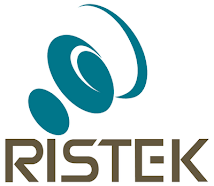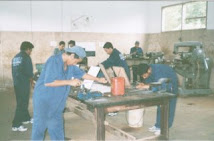Disusun Ulang Oleh:
Arip Nurahman & Deden Anugrah H.
Pendidikan Fisika, FPMIPA Universitas Pendidikan Indonesia
&
Follower Open Course Ware at MIT-Harvard University, Cambridge. USA.
Nuclear Science
A Teachers Guide to the Nuclear Science Wall Chart
 Overview
Overview  The Atomic Nucleus
The Atomic Nucleus  Radioactivity
Radioactivity  Fundamental Interactions
Fundamental Interactions  Symmetries and Antimatter
Symmetries and Antimatter  Nuclear Energy Levels
Nuclear Energy Levels  Nuclear Reactions
Nuclear Reactions  Heavy Elements
Heavy Elements  Phases of Nuclear Matter
Phases of Nuclear Matter  Origin of the Elements
Origin of the Elements  Particle Accelerators
Particle Accelerators  Tools of Nuclear Science
Tools of Nuclear Science  "... but What is it Good for?"
"... but What is it Good for?"  Energy from Nuclear Science
Energy from Nuclear Science  Radiation in the Environment
Radiation in the Environment
![]() Appendix A Glossary of Nuclear Terms
Appendix A Glossary of Nuclear Terms![]() Appendix B Classroom Topics
Appendix B Classroom Topics![]() Appendix C Useful Quantities in Nuclear Science
Appendix C Useful Quantities in Nuclear Science![]() Appendix D Average Annual Exposure
Appendix D Average Annual Exposure![]() Appendix E Nobel Prizes in Nuclear Science
Appendix E Nobel Prizes in Nuclear Science![]() Appendix F Radiation Effects at Low Dosages
Appendix F Radiation Effects at Low Dosages
Please send comments on these chapters to Howard Matis
Kita dilahirkan untuk menjadi PEMENANG.
Keyakinan pertama yang harus Kita miliki sebagai anak manusia adalah keyakinan bahwa Kita dilahirkan untuk menjadi Pemenang. Kita harus percaya bahwa tidak mungkin Allah menciptakan Kita ke dunia ini, tanpa alasan apapun. Tidak mungkin! Pasti ada alasannya, bukan? (tarik nafas perlahan sebentar). Teriakan Semangat Pasti Bisaaaa!!

Lesson Plan
Sekolah Menengah Kejuruan Nuklir Indonesia
(Indonesian Nuclear Cyber school)
by: Bambang Achdiyat (UPI & MIT)
Nuclear Education for K-12 Student
Subject : Physics
Class/Semester : XII/2 (two)
Meeting : 2 Times in a Week
Period : 2 lesson hour (2 x 45 minutes)
Competence Standard : Understanding Concept and principle Electromagnetic wave.
Basic Competence : Understanding and calculation defect mass and binding energy
Indicator :– Identify and explain the characteristic of atom’s compose.
– Explain and formulate defect mass concept.
- Calculate defect mass and binding Energy
- Application of atom energy in the world what for.
I. Objectives
Student can explain about the compose of atom, calculate defect mass and binding energy, make a summery in mind map by working group, and can more attractive in learning process with presentation mind map in front of others, and give question answer each other.
II. Subject Material
1. Atom’s Component
2. Defect Mass
3. Binding energy
III. Model: Cooperative learning (Jigsaw)
Methods:
1. Direct Instruction
2. Discussion
3. Mind Mapping
4. Presentation
5. Simulation
IV. Learning Steps
(Introduction)
1] First Meeting (10 minute)
Teacher begins learning process with greetings and prays. Then open the learning process and then start apperception and prior conception.
A. Apperception. (5 minute)
1. Teacher: as you know that first assumption about atom was expose by Democritus firstly. Finally we know that atom is not the most little matter in this world and atom it appears still consist of others little matter, what is it?
Student’s answer: electron, proton, and neutron
2. Teacher: what will be happening, if there are 2 same charges in a short distance?
Student’s answer: will be repulsive
3. Teacher: who can write in the board the formula of Coulomb force?
Students’ answer me,
4. So, how if there are 2 same charge, and the distance is decreased to be more close, what will be happened to the force?
Student’s answer: the force will increase
Teacher Show Animation
B. First Conception (5 minute)
1. Who is people, you remember when I say, “E=mc2”?
Student’s answer: Albert Einstein
2. What do you know about that formula?
Student’s answer: the equivalence between mass and energy.
3. Do you know that one reason why our country could be freedom is when Nagasaki and Hiroshima is fallen bomb atom by America?
Student’s answer: yes Mr.
4. Do you know how big that bomb, so that could make 2 city asundered?
Student’s answer: not too big, I think.
Teacher show picture or video about that bomb.
5. And do you know, why that bomb have energy as big as like that, could asundered 2 city?
Student’s answer: why…?
Show simulation about benefit of nuclear energy
6. And do you know that if there are same charges in short distance will be there big repulsive force, and closer the distance the repulsive force will be bigger. Why in nucleus, repulsive force between protons is not making it broken, whereas the distance is very short?
Student’s answer: …..
Teacher show Coulomb force simulation
2] Mind Activity (70 minute)
1. Teacher make group of 4, by counting 1 to 4, the same number is one group, which we called as a expert group.
2. Teacher give article about 4 different chapters, 1 chapter for one group. They (students) must to discuss the article in each group till all group members understand.
3. Then all members in group, counting again from 1 to 4 and make new group, all same number in one group new, which we called as Group A, B, C, and D.
* The Chapters to discuss are:
1) Identification and explain the characteristic of atom’s component
2) Explain and formulate defect mass concept.
3) Calculate defect mass and binding Energy
4) Application of atom energy in daily life
4. All members must to explain about they article to others till all member understand in his/her group.
5. Make a summary and relationship between all materials from each article, with mind map.
6. Teacher give work paper each group, like this :
a. What is atom?
b. Is atom truly the most particle in the world, why?
c. What is the composer of atom? How much the composer of atom do you know?
d. Please draw the picture for atom which you know!
e. Could you arrange to the most weight for the composer of atom?
f. Have mass 4,003 amu, mass 1 proton = 1,008 amu, and mass 1 neutron = 1,009 amu.
Search defect mass and binding energy of . (Mass of electron is not respected)
g. What is the sample for using atom energy ever or now is using, which you know?
h. Write here, all information you know about atom beside information from the question above! All you know.
7. Afterward, all answer and mind map is gathered to teacher.
8. Each group delivers 1 member to stand up in front of class to explain the mind map.
9. Each else group give minimal 2 question to every group who presentation, and who must answer is member group presentation beside presenter.
10. Teacher adds information and makes true some knowledge if still there are some misconceptions from the student.
3] Final Activity (10 minute)
Teacher repeat lesson rapidly and short about that lesson (by Power Point) and gives conclusion for each group about what they get today. With this answer teacher can really know how the progress of student cognitive and it’s concept is true or false finally teacher make a self conclusion to cover all answer, and calculate the score for each group in answer the question then give appreciation to all group with certificate.
Then Teacher say to students about material for next lesson
Final Conclusion:
1. Defect mass is difference mass between mass atom and calculating mass the atoms composer.
2. Defect mass is used for binding energy, to keep proton and neutron stay in nucleus.
3. Like when you eat, so will be some mass change to energy, for your grow, repair your body sell, moving, and else.
4. The value of Binding Energy can be show by E=mc2
5. Today the benefit from this energy can use for PLTN, and other source energy.
V. Equipments and substance
Equipments : -
Source : Fisika Dasar SMA 3B, internet.
Media : Power Point and Flash
VI. Assesment
- Student activities when they are discussed, questioning, and answer the question
– Final score from question-answer group in front of class.
- Task (Group and Individual)
- Examination
……………, …………….. 2010
Acknowledging,
Head Master Physics Teacher
____________ ______________
NIP. NIP.
-Articles-
1) Explain the characteristic of atom’s component
Dalam sejarahnya berdasar manuscript yang ditemukan bahwa orang pertama yang mencetuskan materi terkecil adalah demokritus pada abad 4 SM.
Demokritus menyatakan bahwa, atom adalah materi terkecil yang tidak bisa dipecah lagi. Setelah itu sekian abad kemudian konsep atom ini mulai tercetus oleh John Dalton yang menyatakan bahwa atom adalah seperti bola pejal yang tidak bisa di bagi lagi.

1. Atom merupakan bagian terkecil dari materi yang sudah tidak dapat dibagi lagi
2. Atom digambarkan sebagai bola pejal yang sangat kecil, suatu unsur memiliki atom-atom yang identik dan berbeda untuk unsur yang berbeda
3. Atom-atom bergabung membentuk senyawa dengan perbandingan bilangan bulat dan sederhana. Misalnya air terdiri atom-atom hidrogen dan atom-atom oksigen
4. Reaksi kimia merupakan pemisahan atau penggabungan atau penyusunan kembali dari atom-atom, sehingga atom tidak dapat diciptakan atau dimusnahkan.

Penelitian terus berlanjut, dan kemudian J.J Thompson dengan percobaan tabung sinar katodanya, menemukan fakta bahwa ternyata atom bukan materi penyusun terkecil, malahan tersusun oleh materi lain yang kemudian di sebut elektron dan karena atom netral, maka perlu ada anggapan bahwa ada muatan yang bersipat positif untuk mengimbangi sipat kenegatifannya. Oleh karena itu, muncul konsep proton yang pada model ajuan Thompson ini model atomnya adalah seperti “kue onde” dimana atom yang bermuatan positif dengan elektron tersebar merata saling menetralkan. Kelemahan model ini tidak bisa menjelasakn mengenai susunan proton dan elektron pada atom.
Thompson menggunakan tabung katoda penemuan William Crookers , yang menghasilkan pancaran partikel yang disebut elektron. Thompson membuktikan bahwa apapun logamnya sebagai katoda, jika diberi tegangan tinggi maka ia akan memancarkan partikel, ini dibuktikan dengan berputarnya kincir (karena tumbukan momentum partikel), yang dipasang antara katoda dan anoda saat sinar katoda dinyatalan. Dan pernyataan bahwa partikel itu negatif dengan mendekatkan medan magnet pada tabung sinar katoda itu, dan perilakunya yang membelok itu menunjukan bahwa ia memang bermuatan negatif.
"Atom merupakan bola pejal yang bermuatan positif dan di dalamya tersebar muatan negatif elektron"
Penelitian selanjutnya, ilmuan Rutherford dengan percobaannya yang berusaha menembaki atom pada lempeng tipis emas dengan sinar α (bermuatan positif), menemukan bahwa partikel sinar α yang bermuatan positif itu sebagian besar ada yang diteruskan, sebagian dibelokan, dan sebagian lagi balik arah. Ia menyatakan bahwa ada ruang kosong dalam atom yang menyebabkan sebagian partikel alpha diteruskan, ini artinya atom tidak pejal, dan ada yang bermuatan positif massif yang membuat partikel α dibalikan, artinya ada muatan muatan positif di dalam atom. Ia kemudian menyimpulkan bahwa atom tidaklah pejal, melainkan terdiri dari kulit dan inti yang terpisah oleh suatu ruang kosong, di mana elektron menempati kulit dan proton menempati inti yang jumlah proton dan elektron saling menetralkan karena atom yang netral. Hanya saja kelemahan model Rutherford ini tidak bisa menjelaskan kenapa elektron tidak tertarik ke inti, berdasar fisika klasik seharusnya jika elektron itu bergerak mengelilingi inti seharusnya ia memancarkan energi, semakin lama energinya semakin berkurang, dan karena ada gaya elektrostatis dengan inti seharusnya elektron tertarik ke inti, tapi ternyata tidak.
Kemudian Neils Bohr memberikan perbaikan pada model atom Rutherford, dengan percobaannya pada atom hydrogen, dengan menyatakan bahwa elektron menempati daerah kesetimbangannya yang tidak akan memancarkan energi meskipun ia bergerak berputar selama ia tetap berada di tingkatan energi yang sama. Kelemahan model Niels Bohr ini tidak bisa menjelasakan untuk atom berkelektron banyak, berhubung pernyataan Bohr itu baru untuk kasus atom hydrogen dengan 1 elektron saja. Kelebihan model Bohr adalah mampu menerangkan adanya tingkatan energy dalam atom. Kelemahannya, tidak bisa menjelaskan untuk atom dengan elektron banyak, efek Zeeman, dan efek Strack.

Atom kemudian di ketahui bahwa ia tersusun oleh 3 partikel utama yang kita kenal dengan proton, electron, dan neutron. Hampir seluruh massa atom terkonsentrasi di inti. Walaupun sekarang diketahui bahwa, ada partikel lain yang menyusun ketiga partikel itu.
2) Explain and formulate defect mass concept.
Dalam inti atom terdapat 2 jenis partikel penyusun, yaitu proton dan neutron. Hampir seluruh massa atom diwakili oleh seluruh partikel ini yang terkumpul di inti yang ukurannya sangat kecil. Dalam bab listrik statis kita memperlajari bahwa jika ada 2 muatan sejenis maka ia akan saling tolak menolak. Semakin dekat jaraknya maka semakin besar gaya tolakan antara 2 muatan itu. Kemudian bagaimana kalau ternyata dalam inti atom yang sangat kecil itu terdapat sejumlah proton, tentunya gaya tolak menolaknya akan sangat besar, kenapa inti tidak pecah? Hal ini dikarenakan ada gaya lain yang lebih besar yang menahan proton tetap berada di inti, itu yang disebut dengan gaya ikat inti.
Gaya dasar di alam semesta ini ada 4, yaitu : gaya gravitasi, gaya listrik, gaya lemah, dan gaya kuat inti. Gaya kuat inilah penyebab inti tidak pecah. Ternyata, Ia hanya bekerja pada jarak yang sangat pendek, dan keadaan proton di inti telah memenuhi syarat tersebut, sehingga gaya tolak coloumb menjadi tidak terlalu berepengaruh karena gaya ikat inti yang sangat kuat. Berdasarkan eksperimen berikut adalah data menganai massa penyusun atom.: proton 1,6726 .10-27 kg, elektron 9,31.10-31 kg, dan neutron 1,6749 .10-27 kg
Ternyata nilai dari massa atom keseluruhan berbeda dengan jumlah massa total semua partikel penyusunnya, kenapa dan kemana massa yang hilang itu? Ternyata selisih massa (∆m) total penyusun dengan massa atomnya sendiri digunakan sebagai energi ikat dengan perumusan Einstein yang menyatakan E=∆m.c2. seperti massa istotop C-12 yaitu 12 amu (atom mass unit), dan jumlah seluruh penyusunnya (proton, elektron, dan neutron) dalam amu ternyata adalah 12,101627 amu. ada selisih 0,101627 amu. Begitupun untuk atom-atom yang lainnya, selalu ada selisih massa penyusun atom dengan atomnya sendiri berdasar spekrtometer yang disebut dengan defect massa.
3) Calculate defect mass and binding Energy
Berdasar penelitian didapat nilai massa untuk proton 1,6726 .10-27 kg, elektron 9,31.10-31 kg, dan neutron 1,6749 .10-27 kg. Ternyata ada selisih massa (∆m) antara massa total penyusun atom dengan massa atom itu sendiri, ini yang disebut dengan defect massa. Misal isotop atom C-12 memiliki massa 12. 10-3 kg, artinya untuk 1 mol atom C-12, memiliki massa 12 gram, artinya juga massa untuk satu partikel di dapat, = 1,99.10-26 kg. Diketahui nilai dari massa atom isotop C-12 adalah 12 u. Berdasar perhitungan massa untuk 1 amu isotop C-12 di peroleh = 1,66 . 10-27 kg/u. jika dirunut mengenai nilai massa dari penyusun atom C-12 didapat,
6 elektron = 6 . 9,31.10-31 kg
6 Proton = 6 .1,6726 .10-27 kg
6 Neutron = 6.1,6749 .10-27 kg +
20, 0887 . 10 – 27 kg
Massa dalam (u)
= 20, 0887 . 10 – 27 kg = 12,101627 u
1, 66 . 10-27 kg
Sedangkan massa atom C-12-nya sendiri diketahui adalah 12 u, maka ada selisih massa (∆m) sebesar = 12,101627 u – 12 u = 0,101627 u
Nilai massa inilah yang digunakan sebagai energi ikat inti dengan perumusan Einstein (E=mc2)
Maka E = 0,101627 u . c2
= 0,101627 u . 931 MeV/u
= 94,61 MeV
Energi tersebut adalah energi yang digunakan untuk mengikat seluruh komponen inti, sehingga meskipun ada gaya tolak coulomb tidak menyebabkan inti pecah.
4) know the application of atom energy in the world what for.
Sejarah menunjukan salah satu bukti penggunaan energi ikat inti ini (energi yang digunakan untuk mengikat inti) yaitu berhubungan dengan salah satu sebab mengapa negara kita bisa merdeka. Saat Amerika menjatuhkan bom atom di negara jepang tepatnya di kota Nagasaki dan Hirosima, menyebabkan Jepang yang saat itu mendominasi pemerintahan Indonesia memutuskan untuk pulang, dan saat kekosongan dimana pihak jepang pulang maka pihak Indonesia memutuskan untuk memproklamirkan kemerdekaannya pada 17 Agustus 1945. Padahal atom yang dijatuhkan berukuran kecil, tapi menghasilkan energi yang bisa menghancurkan 2 kota.
Selain itu di zaman modern ini penggunaan energi nuklir (energy inti) semakin meluas, salah satunya bermanfaat untuk menjawab krisis energi yang selama ini didominasi oleh miyak bumi dan batu bara yang merupakan sumber daya alam yang tidak dapat diperbaharui dan pengolahannya menimbulkan polusi yang berdampak pada pemanasan global. Berbeda dengan penggunaan energi nuklir, dengan pasokan yang sedikit bisa menghasilkan energi yang begitu besar dan tergolong emisinya bersih, hanya saja biayanya masih mahal dan perlu dukungan sumber daya manusia sehingga bisa mengantisipasi kecelakaan yang mungkin terjadi seperti adanya kebocoran dan lainnya.
Untuk mendapatkan gambaran tentang besarnya energi yang dapat dilepaskan oleh reaksi nuklir mari kita contohkan lebih sederhana. Dengan 1 gr bahan bakar nuklir 235U. Jumlah atom di dalam bahan bakar ini adalah : N = (1/235) x 6,02 x 1023 = 25,6 x 1020 atom 235U.. Karena setiap proses fisi bahan bakar nuklir 235U. disertai dengan pelepasan energi sebesar 200 MeV, maka 1 gr 235U. yang melakukan reaksi fisi sempurna dapat melepaskan energi sebesar : E = 25,6 x 1020 (atom) x 200 (MeV/atom) = 51,2 x 1022 MeV Jika energi tersebut dinyatakan dengan satuan Joule (J), di mana 1 MeV = 1.6 x 10-13 J, maka energi yang dilepaskan menjadi : E = 51,2 x 1022 (MeV) x 1,6 x 10-13 (J/MeV) = 81,92 x 109 J Dengan menganggap hanya 30 % dari energi itu dapat diubah menjadi energi listrik, maka energi listrik yang dapat diperoleh dari 1 gr 235U. adalah : Elistrik = (30/100) x 81,92 x 109 J = 24,58 x 109 J. Karena 1 J = 1 W.s ( E = P.t),
maka peralatan elektronik seperti pesawat TV dengan daya (P) 100 W dapat dipenuhi kebutuhan listriknya oleh 1 gr 235U. selama : t = Elistrik / P = 24,58 x 109 (J) / 100 (W) = 24,58 x 107 s. Angka 24,58 x 107 sekon (detik) sama lamanya dengan 7,78 tahun terus-menerus tanpa dimatikan. Jika diasumsikan pesawat TV tersebut hanya dinyalakan selama 12 jam/hari, maka energi listrik dari 1 gr 235U bisa dipakai untuk mensuplai kebutuhan listrik pesawat TV selama lebih dari 15 tahun.
Selamat dan Terus Maju
Untuk Kelompok A
Dengan Anggota :
1. 6.
2. 7.
3. 8.
4. 9.
5 10.
Atas keberhasilanya mendapatkan predikat terbaik, Untuk Bab ………………….
Maju Terus, tingkatkan selalu prestasi
Contoh Sertifikat,
Group Assessment
Student Worksheet
Member of Group :
1. .
2. .
3. .
4. .
5. .
6. .
7. .
8. .
Questions
1) What is atom?
……………………………………………………………………………………………………………………………………………………………………………………………………………………………………………………………………………………………………….. ……………………………………………………………………………………………………………………………………………………..
2) Is atom truly the least particle in the world, why?
……………………………………………………………………………………………………………………………………………………………………………………………………………………………………………………………………………………………………….. ……………………………………………………………………………………………………………………………………………………..
3) What is the composer of atom? How much the composer of atom do you know?
……………………………………………………………………………………………………………………………………………………………………………………………………………………………………………………………………………………………………….. ……………………………………………………………………………………………………………………………………………………..
4) Please draw the picture for atom which you know!
5) Could you arrange to the most weight for the composer of atom?
……………………………………………………………………………………………………………………………………………………………………………………………………………………………………………………………………………………………………….. ……………………………………………………………………………………………………………………………………………………..
6) have mass 4,003 amu, mass 1 proton = 1,008 amu, and mass 1 neutron = 1,009 amu.
Search defect mass and binding energy of . (Mass of electron is not respected)
7) What is the sample for using atom energy ever or now is using, which you know?
……………………………………………………………………………………………………………………………………………………………………………………………………………………………………………………………………………………………………….. ……………………………………………………………………………………………………………………………………………………..
8) Write here, all information you know about atom beside information from the question above! All you know.
Nuclear Education, Research, and Careers
This site provides students from middle school through college with the opportunity to explore the challenges and opportunities presented in selecting nuclear science and engineering as a field of study and career. It is expected that for most individuals the words "nuclear engineering" will immediately imply nuclear power electrical production, but that is only part of the story.
Nuclear Engineering An academic degree program offered by approximately forty universities in the United States at the Bachelor's, Master's and Doctoral levels. The nuclear engineering curriculum includes reactor systems studies, fuel cycle, materials science, radiation interaction, space reactors, and advanced concepts.
Health Physics An academic degree program offered by approximately twenty universities in the United States at the Bachelor's, Master's and Doctoral levels. The health physics curriculum includes radiation interaction and detection, dosimetry, radiation protection and standards, risk assessment, radiation emergency management, environmental monitoring and assessment, and nuclear waste management.
Nuclear Energy Fission is produced through the splitting of a heavy atom. Fusion occurs when light atoms collide.
Medical Applications Over the past few years great strides have been made by nuclear engineers and health physicists in the production of radioisotopes that are used for medical diagnostics and treatments.
National Security Nuclear engineers have been involved in the policies associated with nuclear non-proliferation.
Naval Propulsion Nuclear power is used to propel aircraft carriers and submarines.
Space Propulsion Nuclear reactors may be used to propel the next mission to Mars and beyond. Read a detailed interview with a nuclear engineer involved in the research related to this project.
Helpful Nuclear Education Links
U.S. Nuclear Regulatory Commission
(NRC) http://www.nrc.gov/
Nuclear Energy Institute
The American Nuclear Society Teacher Workshop Schedule
http://www.ans.org/pi/teachers/workshops/
The American Nuclear Society
U.S. Department of Energy
Nuclear Energy Agency
U.S. Energy Information Administration
World Nuclear Association











